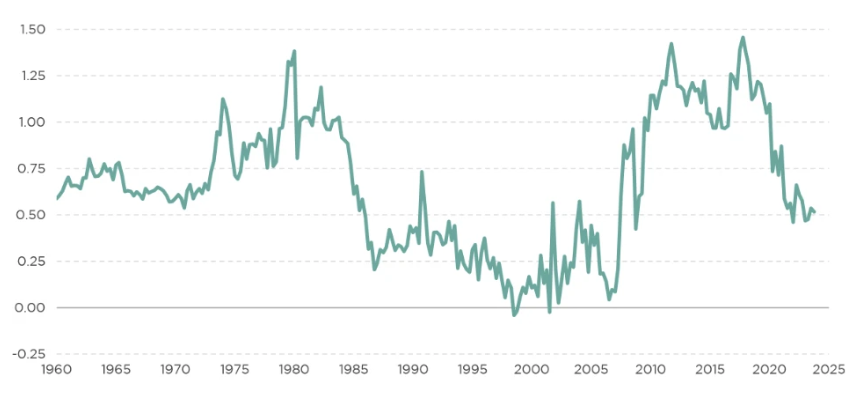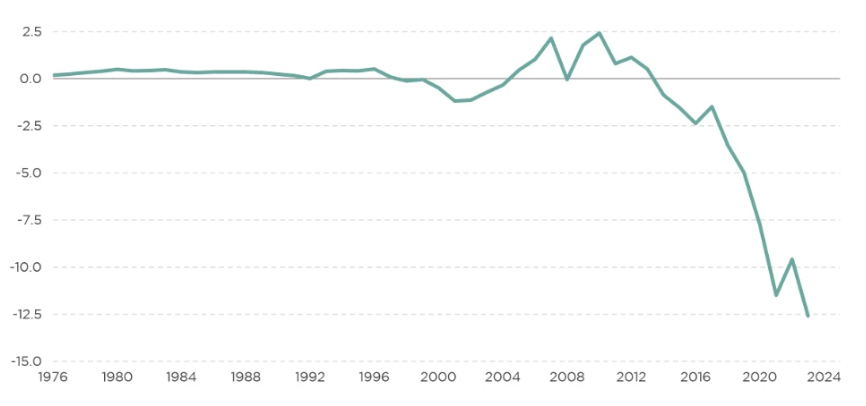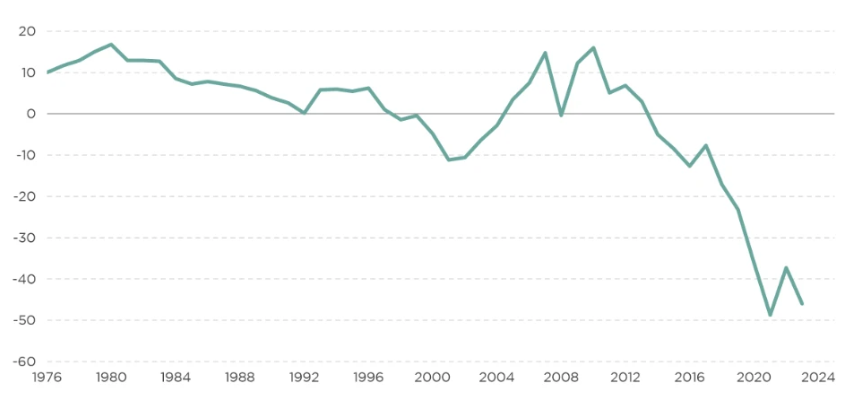The world is overweight US assets, and trillions of dollars are on the line
During the 2000s, following the US equity bear market and the rise of China, the US private sector invested heavily overseas to capitalize on more attractive investment opportunities. Over time, this trend led to a substantial improvement in the US net income balance—namely, the difference between what the US earns on its investments overseas minus what it pays to foreign investors in US assets (see Exhibit 1). While the US remained a net debtor to the world in aggregate because foreign central banks still owned sizeable amounts of US Treasuries, it became a sizeable net creditor to the private sector globally. For the purposes of understanding prospective capital flows and market implications, what matters are the decisions of private sector entities, and by 2012, the private sector held a sizeable short position in the US dollar (USD).
Exhibit 1: US Net Income Balance
As of October 1, 2023. %GDP, Seasonally Adjusted.

Source: Macrobond (© 2024). There is no assurance any forecast, projection or estimate will be realized.
From net short to significant USD long position
Over the last decade, this trend has massively reversed. As I discussed in a recent podcast, it has been the US that has experienced superior growth and asset market performance. On the one hand, the shifting economic model in China, characterized by lower leverage, a weaker property sector, and higher geopolitical risk, and the dual sovereign and banking crises in Europe lowered growth expectations in both regions. On the other hand, renewed technology leadership, resurgent manufacturing, and newfound energy independence via shale gas and oil raised US growth expectations.
As a consequence, private sector capital flows have shifted significantly. Since 2010, foreign investment into the US has surged, such that the net investment position of the US private sector has swung from a $2 trillion (net) surplus to around an $11 trillion (net) deficit. Nearly $9 trillion of that change occurred over the past seven years (see Exhibit 2).
Exhibit 2: US net investment position – Private sector
As of January 1, 2023. USD Trillions

Source: Macrobond (© 2024).
As a share of gross domestic product (GDP), the US has shifted from overweighting foreign assets to the tune of 15% GDP to now underweighting foreign assets in the vicinity of 40% GDP. Alternatively, foreign investors have shifted from underweighting the US by 15% GDP to overweighting US assets by 40% GDP (see Exhibit 3).
Exhibit 3: US Net Investment Position – Private Sector
As of January 1, 2023. %GDP

Source: Macrobond (© 2024).
This is not to say that investors are wrong in favoring US assets. Investors’ overweight exposure to US assets may well be justified if the US continues to offer better returns on investments than those offered in other parts of the world. Indeed, recent US growth and equity outperformance is validating the overweight position.
However, the point here is that investors are already heavily positioned for US growth and asset market outperformance, a dramatic change from investor positioning in 2010. The margin for error for the US is now much, much lower—if the US economy and markets disappoint, there are now trillions of dollars that could exit US markets.
Learn more
Acting with conviction and discipline, we look beyond short-term, conventional thinking to rigorously pursue long-term value across differentiated fixed income, equity, and alternative solutions. For further insights, please visit our website

1 fund mentioned